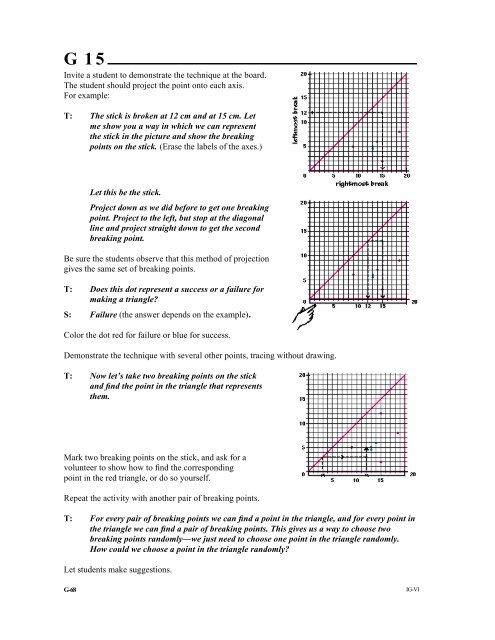Breaking the Stick
Breaking the Stick
Breaking the Stick
Create successful ePaper yourself
Turn your PDF publications into a flip-book with our unique Google optimized e-Paper software.
G 1 5<br />
Invite a student to demonstrate <strong>the</strong> technique at <strong>the</strong> board.<br />
The student should project <strong>the</strong> point onto each axis.<br />
For example:<br />
T: The stick is broken at 12 cm and at 15 cm. Let<br />
me show you a way in which we can represent<br />
<strong>the</strong> stick in <strong>the</strong> picture and show <strong>the</strong> breaking<br />
points on <strong>the</strong> stick. (Erase <strong>the</strong> labels of <strong>the</strong> axes.)<br />
Let this be <strong>the</strong> stick.<br />
Project down as we did before to get one breaking<br />
point. Project to <strong>the</strong> left, but stop at <strong>the</strong> diagonal<br />
line and project straight down to get <strong>the</strong> second<br />
breaking point.<br />
Be sure <strong>the</strong> students observe that this method of projection<br />
gives <strong>the</strong> same set of breaking points.<br />
T: Does this dot represent a success or a failure for<br />
making a triangle?<br />
S: Failure (<strong>the</strong> answer depends on <strong>the</strong> example).<br />
Color <strong>the</strong> dot red for failure or blue for success.<br />
Demonstrate <strong>the</strong> technique with several o<strong>the</strong>r points, tracing without drawing.<br />
T: Now let’s take two breaking points on <strong>the</strong> stick<br />
and find <strong>the</strong> point in <strong>the</strong> triangle that represents<br />
<strong>the</strong>m.<br />
Mark two breaking points on <strong>the</strong> stick, and ask for a<br />
volunteer to show how to find <strong>the</strong> corresponding<br />
point in <strong>the</strong> red triangle, or do so yourself.<br />
Repeat <strong>the</strong> activity with ano<strong>the</strong>r pair of breaking points.<br />
T: For every pair of breaking points we can find a point in <strong>the</strong> triangle, and for every point in<br />
<strong>the</strong> triangle we can find a pair of breaking points. This gives us a way to choose two<br />
breaking points randomly—we just need to choose one point in <strong>the</strong> triangle randomly.<br />
How could we choose a point in <strong>the</strong> triangle randomly?<br />
Let students make suggestions.<br />
G-68<br />
IG-VI

















